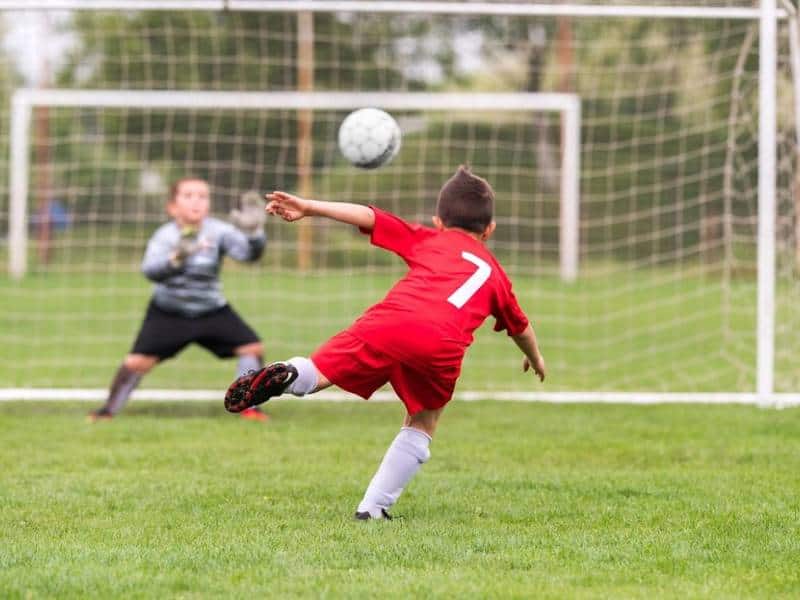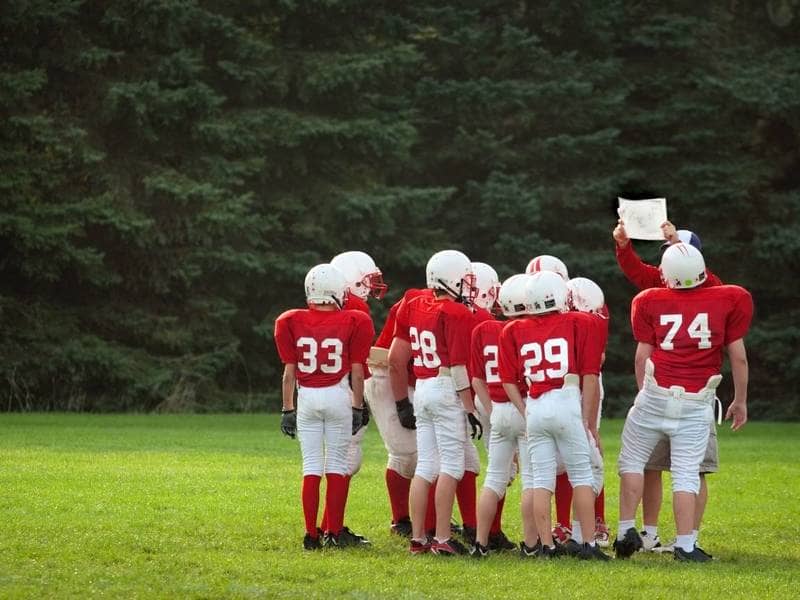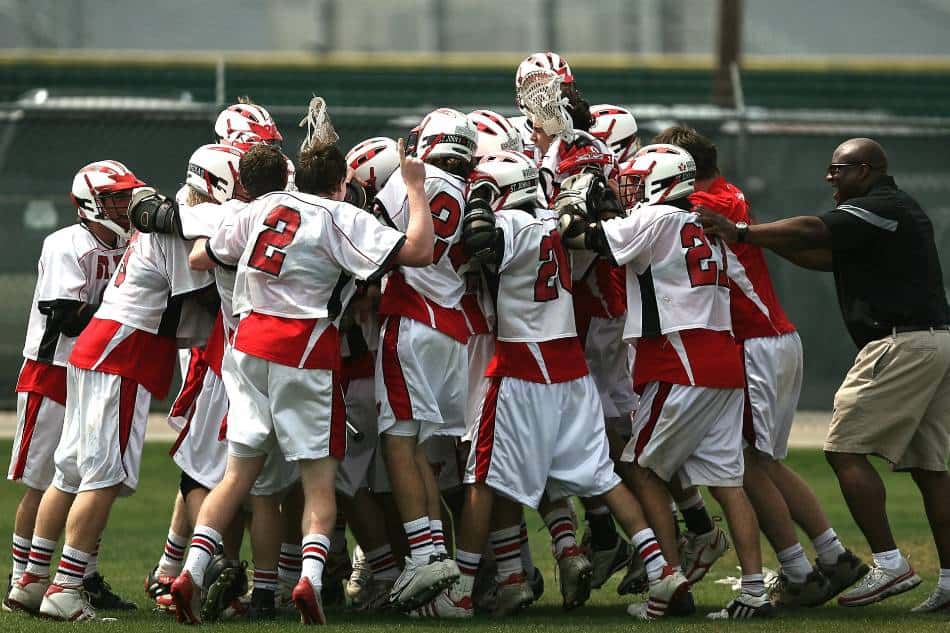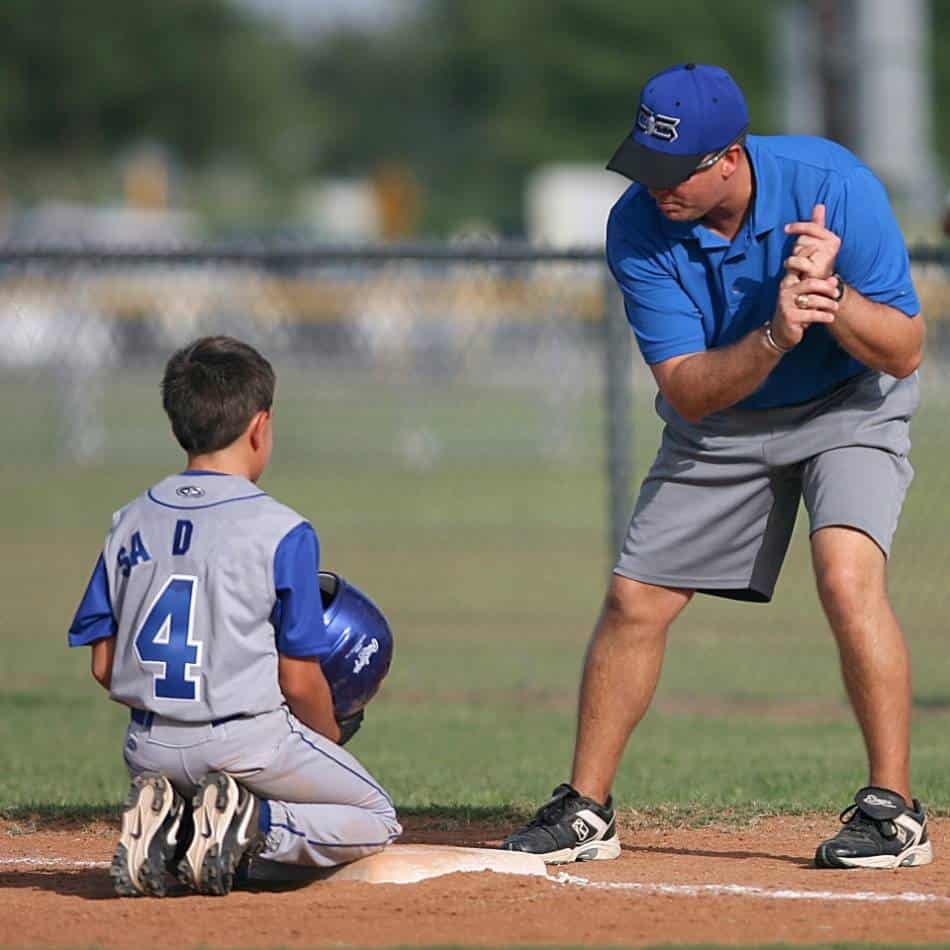
Growing up, I definitely played more on the timid side. I was a stay-at-home defenseman and often opted to play on the safer side as opposed to trying to make aggressive plays and potentially leaving my net exposed. Over time I’ve learned that not playing aggressively and stepping up in key situations was detrimental to my overall game.
So how do you teach kids to be more aggressive in sports?
You can teach kids to be more aggressive in sports in several ways: pushing them but not taking the fun out of the game, helping them understand the games(s), overcoming the fear of failure, setting goals, helping them understand their roles, offering encouragement and more.
It might be difficult for a player to play a more aggressive playstyle right away but over time the process will be well worth it. If you know someone who plays with too much caution, we encourage you to read on so you can offer them advice or to forward them this article.
Pushing Your Child In Sports
As a parent or coach, it’s always important to push your children/players but you also shouldn’t do this to a point that the sport becomes no longer fun to play.
You should let them know that you want the best for them and to guide them in the right direction, instead of being overbearing.
I also believe it’s important to encourage your kids/players to play multiple sports growing up to see which sports they enjoy the most. You want them to cast a wide net to see which sports click with them the most.
I also suggest looking back to when you played sports growing up to figure out what worked best for you and what you could start implementing with your players. In terms of coaches, I’ve had both sides of the spectrum growing up.
I’ve had coaches that let you play but didn’t guide/push you much and I’ve had coaches who’ve made practice and games miserable by being overly pushy.
Luckily for me, I always had supportive parents when it came to sports who wanted nothing but for the best of me.
As a parent/coach, try to find a middle ground between these two extremes otherwise the players probably aren’t going to get any better or enjoy the sport.
Helping Your Players Understand the Game

One way to help players play more aggressively is to help them better understand the sport they’re playing.
In baseball for example, if you’re playing in the infield and a grounder is hit to you, you want to work through the ball as you field it instead of trying to account for the bounce.
Working through the ball helps reduce the chances that the ball takes an unpredictable bounce that can’t be accounted for.
Aggressive play also lends itself to other sports such as soccer and basketball. In soccer, possession is the name of the game and if you have the opportunity to gain it you should do so.
That means when there’s a 50/50 ball, you should probably go for it because you never know what will come from the other team gaining possession.
In basketball, players can play aggressively by proactively going after defensive and offensive rebounds. These rebounds will add up throughout a game and will tilt the probability of winning in one team’s favor.
It’s important defensive rebounds are collected as often as possible because offensive rebounds usually lead to easy points. The concept of aggression can be applied to just about any sport in some way.
Generally speaking, it’s better to be proactive rather than reactive.
Overcoming the Fear of Failure in Sports
Throughout my life, I’ve learned that there’s no reason to fear failure. No matter what sport you’re playing or job you’re working, we’re all going to fail throughout our lives.
This means if you went after a 50/50 ball in soccer or didn’t quite get that rebound in basketball, to keep your head up and keep going. Many people will get stuck in their own heads when something doesn’t go to plan, which will affect them going forward.
If you play or watch a game of soccer, you’d get an idea for how many 50/50 balls there are in a game. Spoiler alert: There’s a ton! Just because you didn’t make it in time to get the ball once or twice doesn’t mean you’re a bad player.
There could be things you need to work on or you might just have been unlucky. With that said, there’s nothing wrong with failing because we’re usually able to take away more from our shortcomings than our crushing victories.
There’s much more you can take away from winning or losing a close game in any sport than winning by a landslide or getting blown out.
Close losses allow you to focus on certain areas of your game that can be improved, while losing or winning big doesn’t offer you much.
As a parent, coach or even a player, you can advise others to let them know what you see when they play and what they could improve on. In the heat of the moment, we usually can’t reflect 100% accurately on what transpired.
A third party offers another perspective on the situation that is usually less biased than the one in our heads.
If you know someone who gets down on themselves easily when they come up short, just point to some professional athletes. For example, we could consider Mike Trout as being one of the best baseball players ever, but even he fails seven out of 10 times at the plate.
Another example is Lionel Messi. He’s in the conversation for greatest soccer player to ever play, yet he hasn’t won a World Cup. The thing that both these players have in common is that they use their failures to get better.
Even if you never play a sport professionally (statistically speaking you probably won’t), coming up short in sports helps you build resilience, which applies to all aspects of life.
“You miss every shot you don’t take.” – Wayne Gretzky
Setting Goals in Sports

No matter who you are, you need to set goals for yourself. The purpose of creating goals is to give you something to shoot for, rather than going through the motions.
I would recommend setting many small goals for yourself and a couple of big goals because you’ll achieve smaller goals quicker, which will help motivate you to achieve your larger goals.
These smaller goals could be something as simple as giving 100% during a game or going after more rebounds. By setting these goals and then achieving them, you’ll realize that you’re capable of improving your abilities which will only help you down the line.
Like in the case of small goals, you should set multiple big goals. Having big goals gives you a target to ultimately reach, which can help you showcase your hard work.
These goals can be just about anything you can think of. They could be leading your team in rebounds this season, scoring the most goals on your soccer team this month or stealing 20 bases this season in baseball.
The great thing about achieving your goals is that they most likely not only make you a better athlete but that they also increase your confidence in and out of sports.
This newfound confidence will help you mentally by letting you know that you’re capable of great things. I also encourage you to set more goals for yourself as you start completing your original goals.
Increasing Motivation in Sports
Proper motivation can go a long way to helping someone become a more aggressive player. Motivation could come from a third party (extrinsic motivation) or it could come from within (intrinsic motivation).
Both forms of motivation are effective ways to help someone improve their overall game.
Extrinsic motivation isn’t created by someone themselves but rather from some kind of reward or goal.
Examples of extrinsic motivation are: receiving a reward for scoring the most goals on your soccer team in a season, earning extra time on the Xbox for giving it your all during a game, playing harder to try to impress someone and the list goes on.
On the other hand, intrinsic motivation is developed from within. Intrinsic motivation is all about doing things because you want to, not because you’re going to receive a reward.
Wanting to be the very best at soccer because you love soccer would be an example of intrinsic motivation.
If you play a ton of baseball because it’s fun to play, that’s intrinsic motivation as well. Playing a sport because you want to earn a scholarship would be extrinsic motivation.
Generally speaking, it’s better for someone to be intrinsically motivated instead of extrinsically motivated. You’re more likely to keep yourself intrinsically motivated over a long period of time than you are through extrinsic motivation.
It’s better to play for the love of the game!
Building Confidence in Athletes

One of the best ways to help players play more aggressively is to compliment them when they make aggressive plays. Praising players after they make an aggressive play will help reinforce these desired habits. It’s also important to be specific with praise.
Instead of just saying “good job Johnny”, try saying “way to chase down the quarterback Johnny!” The more specific you can be when encouraging your players, the more likely they’ll interpret it as genuine, which will benefit them more.
Encouragement shouldn’t be reserved for when players only do things correctly. It should also be given when players get down on themselves. The purpose of this is to help the players not second guess themselves during practices or games.
The less players are sure of themselves, the less likely they’re going to assert themselves in situations where aggression is key.
We should focus on building the confidence up of our players through any means possible because confidence in the sporting world translates to confidence in life.
Aggression vs Hostility
One thing that should be made clear is that aggression and hostility aren’t the same thing. When talking to your players/kids about playing more aggressively, let them know that they’re probably going to initiate contact and commit fouls on occasion.
If they’re going for a 50/50 ball in soccer and end up bumping into an opposing player, that’s going to happen from time-to-time. Encourage your players to help the other team up or to move on right away in these situations.
Players should also take heed of how many fouls they have on them or have committed over a game. A player who has a yellow card in soccer or multiple fouls in the early minutes of a basketball game should tone down the aggression.
If they don’t, they are liable to pick up additional fouls and potentially get ejected from the game.
On the other hand, a player shouldn’t deliberately foul the opposing team if they don’t get their way or if the other team does something they don’t like. Injuries of all kinds are bound to happen playing sports anyway, so there’s no reason to cause them needlessly.
These are some examples of hostile actions you should avoid: swinging your elbows in basketball, slide tackling a player purposely in soccer, throwing at a batter on purpose in baseball, tackling the quarterback below the knees and the list goes on.
Many of us treat our various sports as more than just games, but sometimes we need to remind ourselves that they are simply that – games.
Focus on Having Fun with Sports
Teaching your kids or players to be more aggressive in certain situations and in general will be much easier if they enjoy the sport they’re playing. If they enjoy the sport, they’ll naturally want to become better players, which oftentimes involves more aggressive play.
Players who don’t enjoy what they’re doing are unlikely to push themselves to get better. This means that you should try and make practices more fun by incorporating games and by mixing it up.
While conditioning has its place in any sport, it shouldn’t be the main focus all the time.
By having more fun during practices and games, the players will be more receptive to what you have to say as a coach or a parent. If they’re not having fun playing the sport, the situation should be evaluated to find out the reason.
Helping Players Understand Their Roles

A great way to teach aggressive play is to help the players understand their roles on the field. Each position on the field or team has a different job, so a blanket coaching approach to aggression won’t prove effective.
For example, a defender and attacker in soccer play their positions very differently for good reasons.
An attacker can afford to play more aggressively because if he ends up not winning a ball, there isn’t an immediate threat that the other team will score right away.
In the case the attacker wins the ball, he’s on the opposing team’s side of the field and will likely have a goal-scoring opportunity.
On the other hand, if a defender overplays a ball and doesn’t result in possession, the other team is going to have a prime goal-scoring opportunity. Aggressive playstyles benefit certain players/positions more than others.
Let’s take a look at aggressive play in baseball. For instance, first basemen need to be quite aggressive when digging balls out that are thrown to them.
This is because many of the throws come from the left side of the infield, which requires longer and harder throws.
Some of these throws are bound to hit the ground before reaching the base and it’s up to the first baseman to work through the ball and take away any potential bad hops.
On the other hand, an outfielder may play less aggressively by not diving after a ball or by dropping to one knee to field a ball. By diving after a ball, you may make an amazing play and get an out but you might also miss the ball and let it roll to the fence.
This effectively allows a single or double to turn into a triple or inside the park home run.
The same goes for dropping to one knee to field a ground ball. If the batter hits the ball to the outfield and there’s no way of getting him out at first and he’s unlikely to advance to second, drop to one knee to ensure the ball doesn’t get by you.
Letting the ball get by you is only going to let a single turn into a double or a triple. No matter what sport you play, the amount of aggression you should show depends on your position and the situation.
